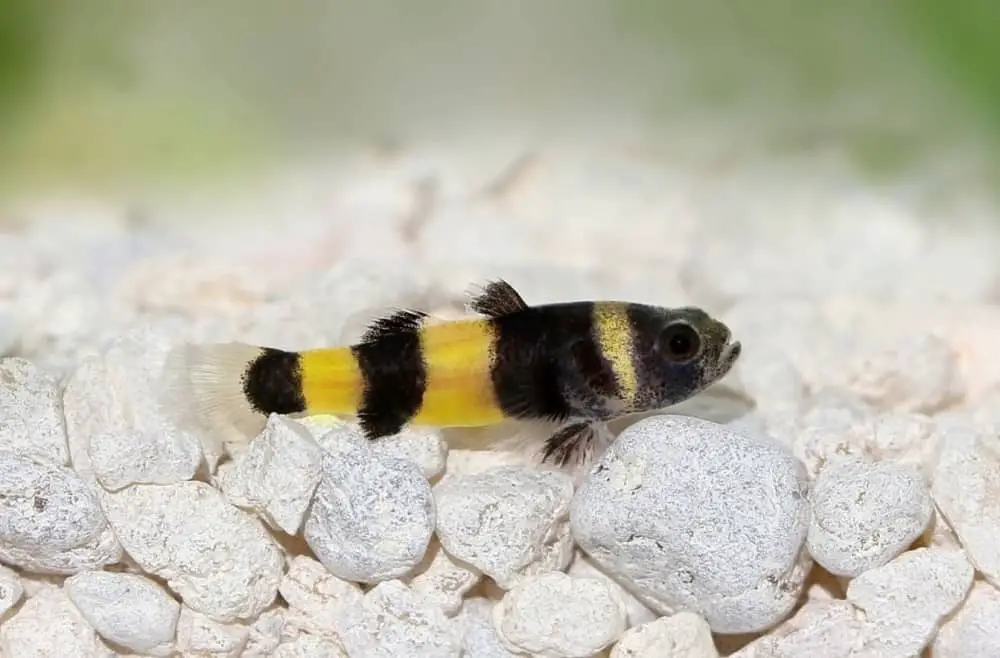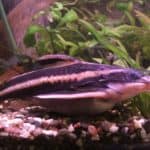The Bumblebee Goby is a unique brackish and freshwater species that is native to Thailand and Indonesia. Usually, they are found inhabiting estuaries and swamps, although they can be kept in aquariums.
Aside from bumblebee goby, they are also referred to as Brachygobius Xanththozona. As implied by its name, this species has a similar appearance to that of a bumblebee.

Care Guide
If you plan to keep bumblebee gobies they have certain requirements that you must make yourself aware of.
Tank Size
As the bumblebee goby is a small species, they do not require a huge tank. Ideally, it should measure around 10 gallons. You must make sure that the tank is not overcrowded.
In doing so, you will likely find that these fish live lengthy, healthy lives. Remember that these fish need enough space to be able to travel through the water freely.
Tank Mates
These fish are known to display competitive behaviors when it comes to food and this can make it difficult to keep them in a community tank. Also, they have quite specific needs when it comes to the water that they live in.
As such, it may be better to keep them in a tank with their species. Whilst you of course want to choose a species that you like, you need to make sure that they are compatible.
Should you decide that you still want to keep more than one species inside your aquarium you may choose to add some mollies or guppies as they have peaceful temperaments.
Alternatively, you can add some shrimp, however, you must make sure that you select large shrimps so that the bumblebee gobies do not view them as food.
Same Species Tanks
Bumblebee gobies cope better when kept in a single species tank. As mentioned, they aren’t aggressive but they have quite specific needs. Keeping bumblebee gobies together means that you do not face any compatibility issues.
As a sociable species, you should keep a bumblebee goby in groups as they can endure unnecessary stress when kept alone. A group of approximately 7 of these fish can be kept inside a tank that has a 10 to 15 gallon capacity.
Water Parameters
In the wild, Bumblebee Gobies live in brackish water where there is a combination of freshwater and saltwater. Usually, they tend to stay in shallow water where they can avoid potential threats from larger species.
Ideally, the conditions in the aquarium that you set up should replicate those of their natural habitat. Whilst some fish cope in freshwater, most tend to stick to water that has low salinity levels.
It helps to consult the breeder for information regarding how they raised these fish because you can then ensure that you mimic the same quality of the water. There is then a better chance of your fish thriving and living a healthy life.
The temperature of the water should be between 72 and 84 degrees Fahrenheit and the recommended pH level is between 7.0 and 8.5. The salinity levels should be between 1.002 and 1.006.
If necessary, you can use aquarium salt to make sure it is at the correct level. Moreover, you should also make sure that the pumps inside the tank are not too powerful and not likely to create strong waves because bumblebee gobies are not going to tolerate this very well.
What To Put In Their Tank
You should furnish your bumblebee gobies aquarium with a soft sandy substrate. Use this sand to create a base layer at the bottom of the tank. Certain types of sand are going to keep the water alkaline and hard. Smooth sand is going to be easier for this species to dig into and will also minimize the risk of injury.
As a species that enjoys hiding, you must make sure that you provide them with plenty of hiding spots. Ideally, the decorations should be natural. You can add rocks and driftwood as well as lots of plants.
The plants are going to provide them with natural shelter against the light. You must remember to make sure that the plants that you select are suitable for brackish water conditions.
Moreover, you should also ensure that you have a filtration system and a heater set up. The heater will regulate the temperature of the water. The filtration system is going to help to keep the water clean. Neither of these things need to be overly fancy.
Common Diseases
Bumblebee gobies are affected by disease, however, they can be regulated and controlled through the ways that they are cared for. Water quality is super important for this species and failure to maintain this can inflict disease upon them.
If the salinity levels of the water are incorrect your fish can suffer from diseases that have been inflicted upon them as a result of stress.
If you take a bumblebee goby from brackish water and add it to freshwater when it is not used to it, you will find that their body goes into shock. You should regularly test the water to make sure that it is always of good quality.
Food & Diet
These fish can be fussy eaters. Their diet should consist of plenty of nutrients as this will keep them strong and healthy.
As carnivores, they enjoy a combination of frozen foods and live foods and will usually refuse to eat dried foods such as flakes. You can feed them things such as daphnia, brine shrimp, bloodworms, tubifex worms, and mosquito larvae.
Unfortunately, their fussy eating habits can deter some potential owners. It is important to remember that their dietary preferences can differ between fish. Some will like foods that others dislike and vice versa.
Lifespan
The bumblebee goby has a lifespan of around three years when cared for properly and kept in optimal conditions. There are instances where they have lived for slightly longer than this.
Appearance
As expected from its name, this species looks similar to a bumblebee. Their bodies are covered with thick black and yellow stripes. The shade of yellow can differ between fish. Some can have pale yellow stripes whilst others can have orange stripes.
Typically, they have clear fins although in some instances they will be striped too. In regards to their body shape, they have small round heads and slender bodies. Moreover, they have short dorsal fins and round caudal fins.
Size
The size of a bumblebee goby can range from 1.5 to 4cm, even when fully matured, they do not reach a large size. Female bumblebee gobies tend to be slightly fatter than males with a round abdomen that allows them to hold their eggs.
Behaviour & Temperament
As we have touched upon, this is not an aggressive species. In fact, they are known for their passive and peaceful characters. Rather than show signs of aggression, usually they prefer to hide.
Initially, they are rather shy but they become more confident as they familiarize themselves with their surroundings. When kept in an aquarium with their own species they are sociable although they can occasionally be a little territorial.
Breeding
Although it can be quite difficult to breed bumblebee gobies, it is possible to do so in the right conditions. The perfect living conditions and a nutritious diet both play an important role in encouraging spawning. When they are ready for breeding the females will begin to swell and the males will be a brighter color.
The females can lay up to 200 eggs at a time and she will do so in hiding locations inside the tank.
Once they have laid the eggs, the females will usually then leave them and the males will take on the responsibility of guarding them. The eggs can be removed from the tank once they have hatched otherwise there is a risk of them being eaten.
Gender Differences: Male vs Female
There are noticeable differences in the appearance of male and female bumblebee gobies as previously mentioned. Not only do the males tend to be slimmer, but they are also usually a slightly different color. The females tend to be larger and their heads are normally rounder.
Fun Facts
- This species loves to swim in open waters.
- Freshwater bumblebee gobies are quite rare. For this reason, you must make sure that you get them from a trustworthy breeder and check that they have always been kept in freshwater.
- They should be fed a small amount of food at regular intervals throughout the day.
- Young bumblebee gobies start by swimming in the upper sections of the water before eventually settling close to the substrate as they get older.
- In some instances, bumblebee gobies can be quite quarrelsome. Because of this, they should be kept in bigger groups because this means that there isn’t one fish that is bearing the brunt of these actions, instead, it is spread out between a bigger group. You need to make sure that you do not overcrowd the tank.








